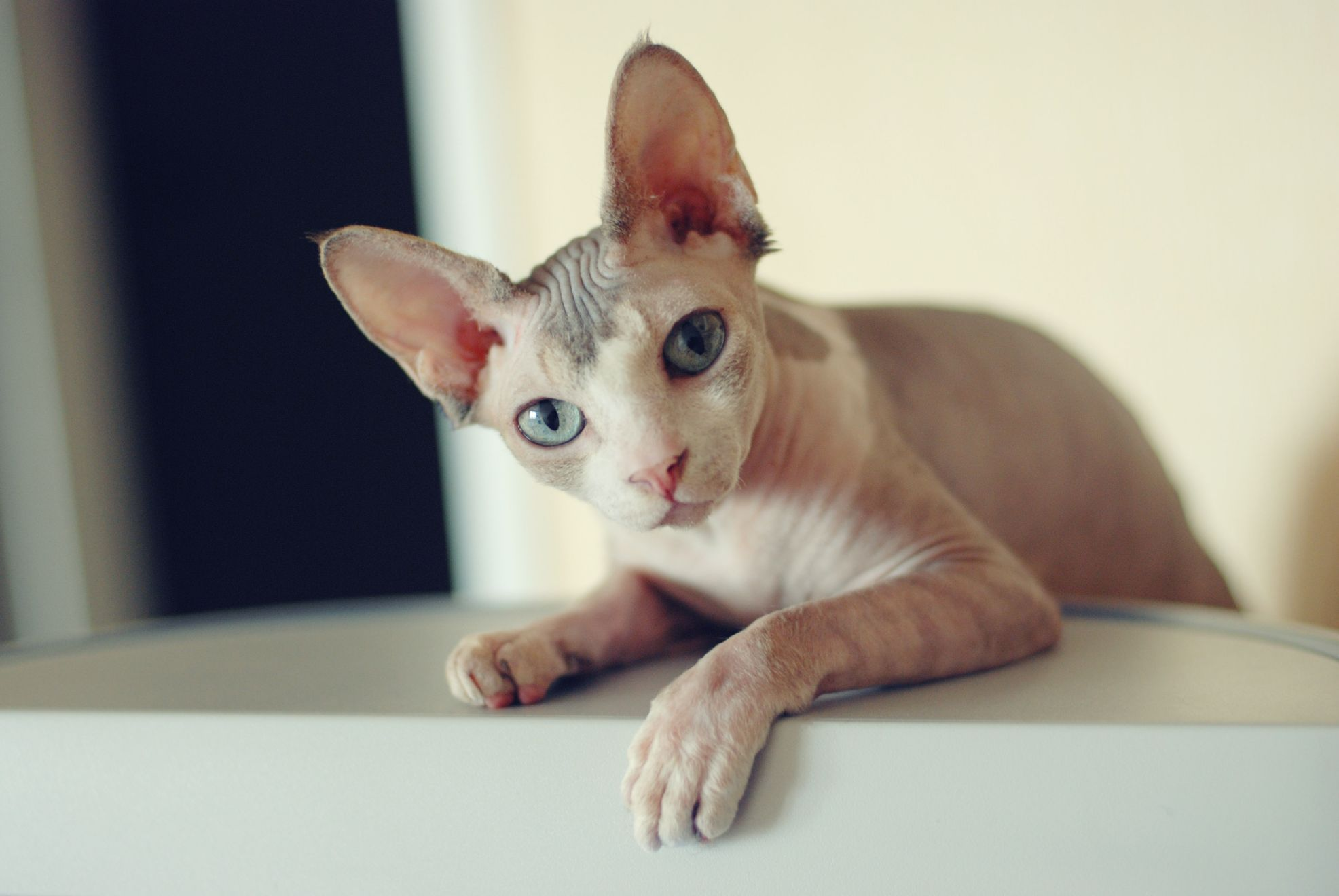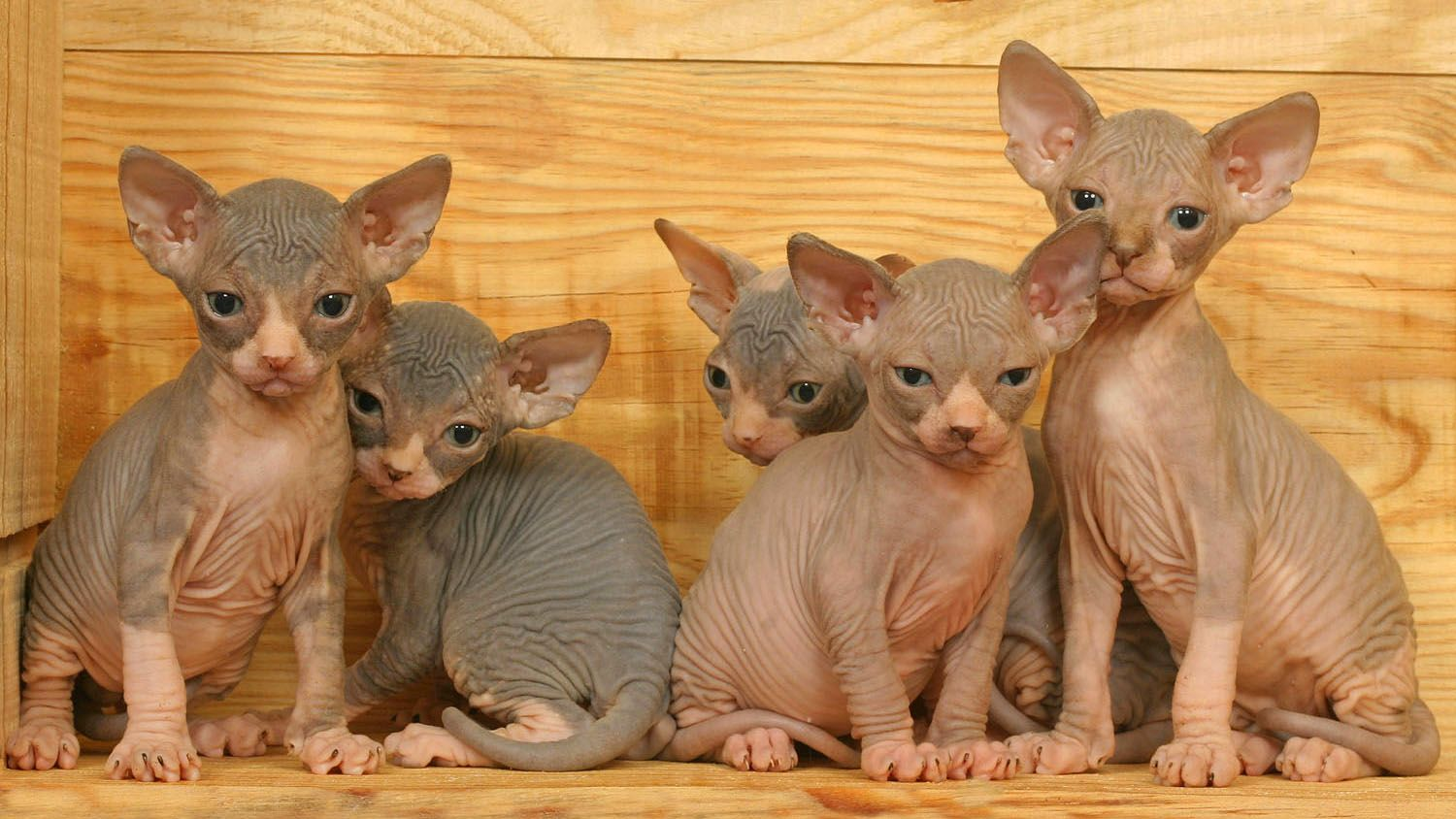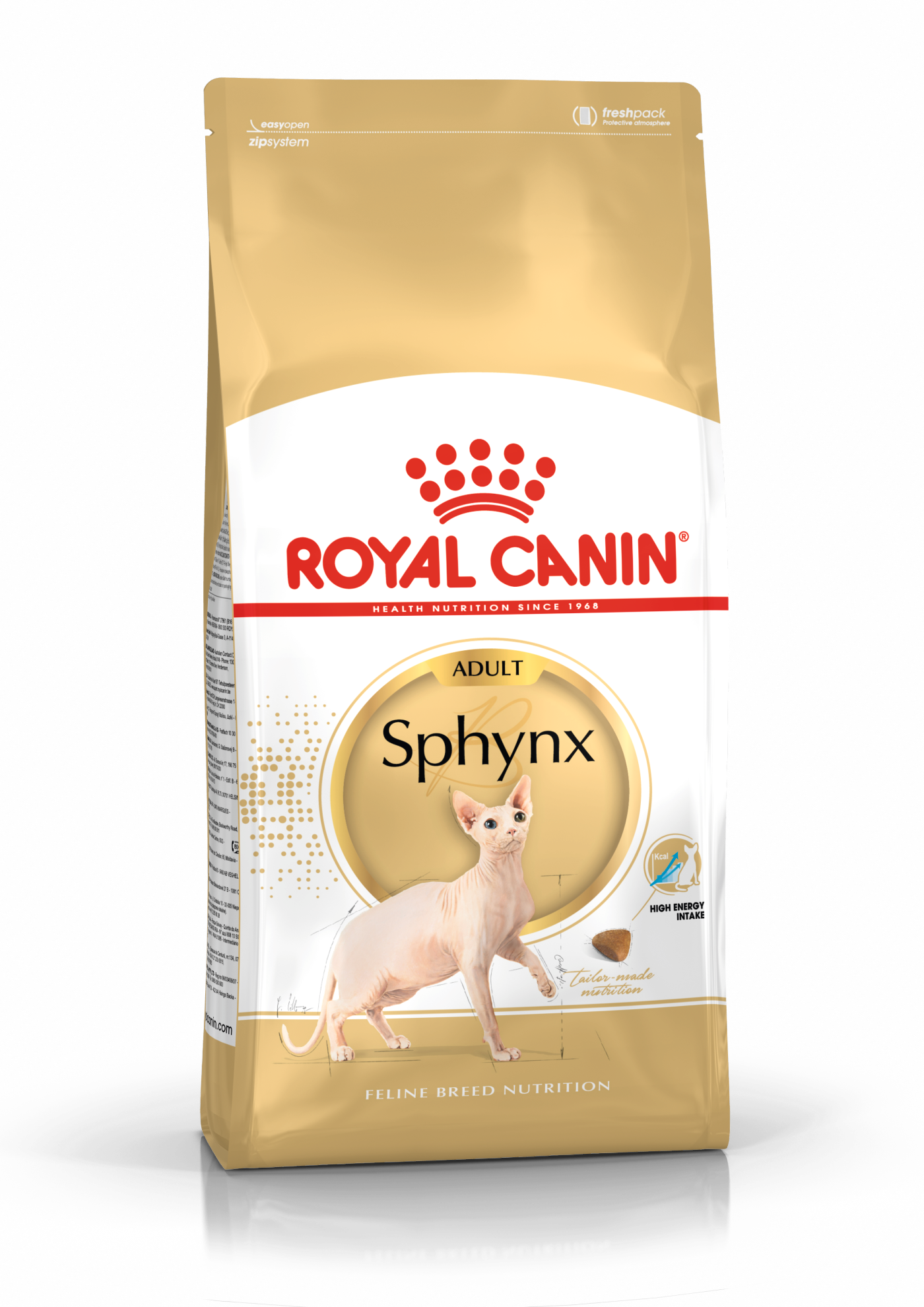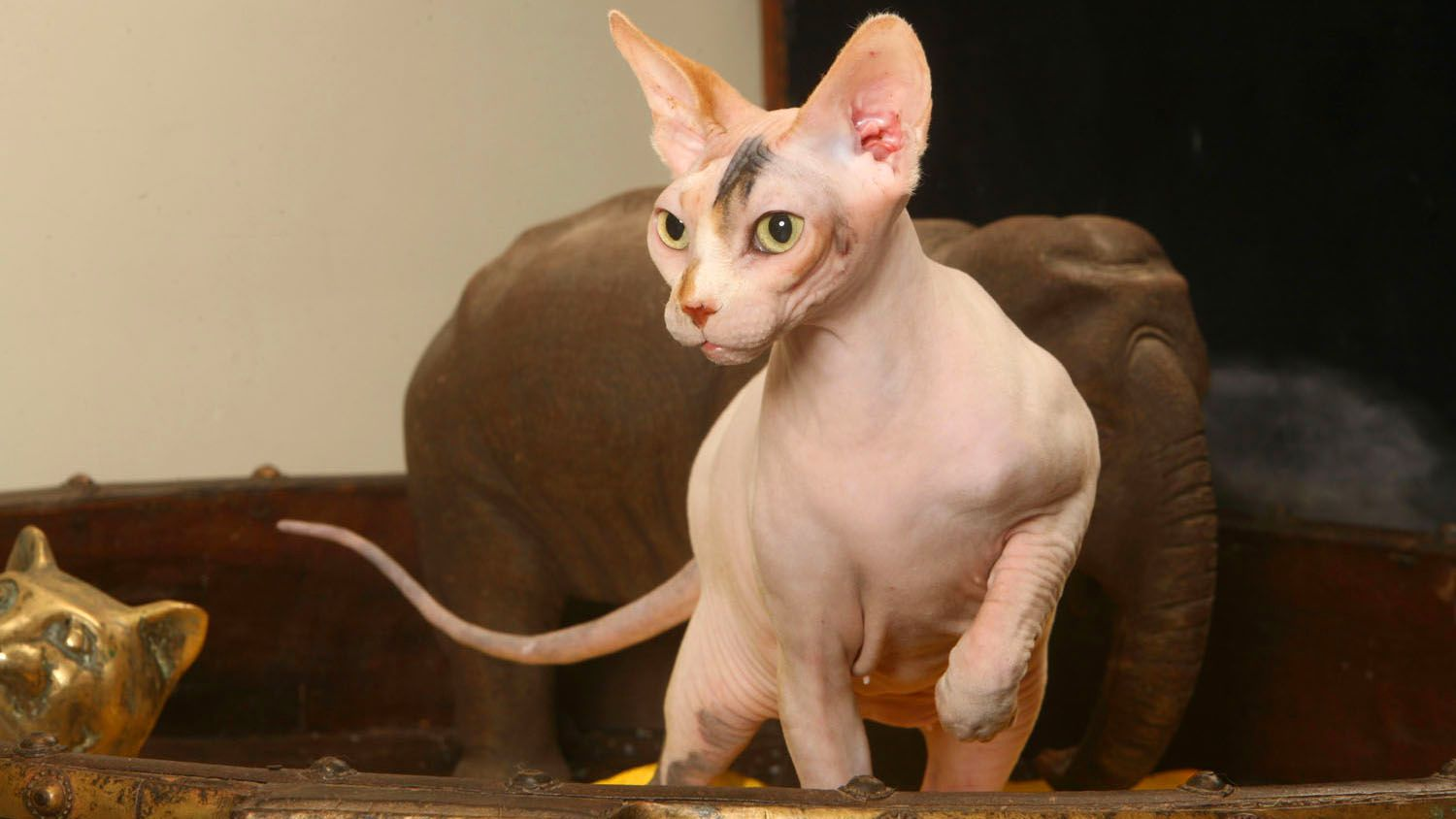Let's talk Sphynx
There is no mistaking the Sphynx cat. Unique among felines, the hairless breed is covered instead in a down-like coat flowing with sweet wrinkles. Highly personable and a mega-cuddler, lovers of the breed can’t get enough of their attentive characteristics. The Sphynx is fine if left alone but overjoyed to be with their humans, and will let you know in no uncertain terms when they need more attention.
Official name: Sphynx
Other names: Canadian Sphynx, Canadian Hairless Cat
Origins: Ontario, Canada
Grooming needs
3 out of 5Energy level*
4 out of 5Vocal
3 out of 5Environment (indoor/outdoor)
2 out of 5Family pet?*
5 out of 5Compatibility
5 out of 5Can stay alone
4 out of 5
| Life Stage | |
|---|---|
| Kitten | Adult |
| 4 to 12 months | 1 to 7 years |
| Mature | Senior |
| 7 to 12 years | From 12 years |
Grooming needs
3 out of 5Energy level*
4 out of 5Vocal
3 out of 5Environment (indoor/outdoor)
2 out of 5Family pet?*
5 out of 5Compatibility
5 out of 5Can stay alone
4 out of 5
| Life Stage | |
|---|---|
| Kitten | Adult |
| 4 to 12 months | 1 to 7 years |
| Mature | Senior |
| 7 to 12 years | From 12 years |
Tailored nutrition for your Sphynx

Get to know the Sphynx
All you need to know about the breed
Not all cats were created equal. The Sphynx is the most extra-ordinary of cats - no real coat to speak of?! - and the most typical of a-typical felines. Not just good but great natured, their doting expression shines out from lemon-shaped eyes crowned by inches-high ears. There’s no other way to put it: This is one cool cat.
Although the breed appears to be from the ancient world, they originate from the cold climes of Canada: in 1966, the first Sphynx cat was born to a domestic cat, and was nothing more than a genetic mutation. The breed has also been called by the name Canadian Hairless Cat.
The Sphynx cat temperament is divine. They are always up for a cuddle or a turn on your lap. This is a velcro-cat, for sure, both lively and affectionate. The breed adores to be held and truly craves attention, and when they don’t receive it, will all but get in your face to ask for more. Not a huge talker, the breed is nonetheless communicative, but it’s all because they dig being part of the pack.
Now, about that coat…that fur…that covering…The Sphynx is encased in a soft, fine down-like topper that doesn’t have many matches in the animal kingdom. Think Chamois. The breed can at times be totally hairless as well, thus sporting skin and nothing else. Applying a vet-approved moisturiser or scent-free oil is necessary to protect the coat - which means weekly baths with moisturising or baby shampoo to keep oils from mussing the furniture. The skin naturally folds over the Sphynx body.
As if all this wasn’t enough, the Sphynx cat fur comes in a variety of chic color combinations, ranging from blue, to black tortie and white, to red and white.
And don’t they just look super smart?? That’s because they are. Their wise gaze gives them a sort of feline one-upmanship, as if they possess all the knowledge in the world, if that’s alright with you. We’ll never know. And that is perfectly fine.

2 facts about Sphynx
1. Not a hypoallergenic breed
Despite their lack of fur, the Sphynx cat is not a hypoallergenic breed - meaning possessing a coat that makes them non-allergy-provoking to the humans in their midst.
2. A live hot water bottle
One would think a cat without fur would be
cold to the touch: not so the Sphynx.
This is a cat that runs hot: the breed
has a higher body temperature and burns calories faster than other felines.
Your cat will still need to be kept warm however for optimum health.
History of the breed
One look at the Sphynx’ cats unparallelled appearance and thoughts of exotic origins in the Far East come to mind. Actually, it’s just the opposite: They originate from Toronto, Canada. Not that Canada isn’t exotic, mind you. In 1966, the first known Sphynx was born to a domestic cat named Elizabeth, a unassuming black and white feline who produced a genetic mutation.
The kitten, known as Prune, was quickly bred by their owner with other hairless cats and the breed took hold. The Sphynx breed was crossed at that time with the Devon Rex, a breed emanating from England with similarly large ears and a very short coat. The hairless kittens, however, prevailed.
The Sphynx has been also called by the name Canadian Hairless Cat but eventually acquired the present name since their appearance compares to cat-like images found in ancient Egypt.
From head to tail
Physical characteristics of Sphynx
1.Ears
2.Head
3.Body
4.Tail
5.Coat

Things to look out for
From specific breed traits to a general health overview, here are some interesting facts about your Sphynx
They can be prone to cardiac problems
When properly bred, Sphynx cats are healthy and lead a robust life. The breed does, though, run the risk of hypertrophic cardiomyopathy, a cardiac condition that can be hereditary, characterised by a thickening of the walls of the heart. It sounds dangerous but is able to be controlled by medication if the condition arises. Make regular visits to your veterinarian to rule out any possibilities.
How hairless is she?
The interesting part about the hairlessness of the Sphynx cat is that there are different degrees of hairlessness. Some cats have the feel of suede, whereas others have a smooth, buttery sensation to their coat. Certain Sphynx possess slightly thicker patches of fur on their nose and ears or their toes and tail. The Sphynx’ covering is like a silky down, but in no way is there no hair at all.
Why the big belly?
The Sphynx anatomy is such that they are sound all around - even though they look fairly delicate. Perhaps it’s the absence of fur but they are in reality hardy cats, and that includes their mid-region. Often called a pot belly, their tummy is firm and taught, as if they’ve just finished a big bowl of kibble. What to feed a Sphynx cat then? Ironically, because of their lack of hair, they should eat more than other cats who would normally have enough plush covering to keep themselves warm. Because of this, breeders green light eating kibble at will - food left out to snack on.
Healthy diet, healthier cat

Tailored health nutrition has a fundamental role to play in maintaining the health and beauty of Sphynx cats. Food provides energy to help with vital functions and a complete nutritional formula for Sphynx should contain an adapted balance of nutrients. Feeding them in this way will offer a diet that’s neither deficient nor excessive, both of which could have adverse effects on your cat’s health.
Clean, fresh water should be available at all times to support good urinary regularity. Cats are also naturally adapted to eating small servings - between 7 and 10 times a day. Giving them the recommended daily ration of kibble once a day will let your Sphynx cat regulate their own consumption.
The following recommendations are for healthy animals. If your cat has health problems, please consult your veterinarian who will prescribe an exclusively veterinary diet.
Growth is an essential stage in a kitten’s life. It is a time of big changes, discoveries, and new encounters. When it comes to their energy, protein, minerals, and vitamin requirements, a Sphynx kitten’s are much greater than those of an adult cat. They need energy and nutrients to maintain their body, but also to grow and build it. A kitten’s growth comes in two phases:
Construction - From Birth to 4 Months:
Weaning is the transition a kitten makes from liquid - or maternal milk - to solid food. This period naturally corresponds to the time when they cut their milk teeth, at 3 to 6 weeks old. At this stage, kittens are not yet able to crunch, so a soft meal (rehydrated kibble or an adapted wet food) helps facilitate the transition between liquids and solids. Between 4 and 12 weeks after birth, the natural immunity a kitten receives from the mother’s colostrum - or first milk - decreases while the kitten’s immune system gradually develops. This critical time, called the immunity gap, requires a complex of antioxidants, including vitamin E, to help support their natural defences. Kittens go through an intense and particularly delicate period of growth during which they’re prone to digestive upset. Their diet at this time should not only be rich in energy to meet their essential growth needs but should also contain highly digestible protein for their digestive system that’s still maturing. Prebiotics, such as fructo-oligosaccharides, can also support their digestive health by helping to balance intestinal flora. The result? Good stool quality, all around. The kitten’s food should contain omega-3 fatty acids - EPA-DHA - which helps support the proper neuro-cerebral development.
Consolidation and Harmonisation - From 4 Months to 12 Months:
From the fourth month, a kitten’s growth slows down, so a food lower in fats is recommended. This is particularly important after a cat is sterilised. Between 4 and 7 months, a kitten’s milk teeth fall out and are replaced by permanent ones. When the adult teeth have come through, a kitten needs to eat kibble that’s of the right shape and texture so it can be easily grasped and so that they’re encouraged to crunch, thus supporting oral hygiene. Until they’re 12 months old, a Sphynx kittens’ immune system is still gradually developing. A complex of antioxidants, including vitamin E, can help support their natural defences during this time of big changes, discoveries, and new encounters. An adapted level of energy and precisely balanced vitamins and minerals, including vitamin B, can help support the cat’s healthy growth while contributing to the skin’s role as a barrier and to maintaining its health. The digestive system matures progressively, with digestive aptitudes reaching full maturity toward twelve months of age. A cat is then able to consume adult food.

The main nutritional goals for adult Sphynx are:
Meeting their high energy needs. To compensate for their hairlessness, Sphynx cats have a very high metabolism which helps to regulate body temperature in what’s called thermoregulation. The process uses large amounts of energy, so their food should be rich in fats and proteins to meet their nutritional needs.
Helping to preserve the health of their skin and contributing to reducing skin irritation by supporting its role as a barrier with targeted nutrients, such as omega-3 and omega-6 fatty acids.
Supporting cardiac function and maintaining cardiac health. Hypertrophic cardiomyopathy is a hereditary heart disease known to affect the Sphynx. A diet rich in taurine can help contribute to superior cardiac muscle function.
Supporting good oral hygiene thanks to a kibble shape that’s the right size for their jaw, with a texture that induces chewing and ensures that the tooth penetrates deeply into the kibble.
Helping to maintain a healthy urinary tract system.

A senior cat - one over the age of 12 - may sometimes have difficulties with absorption. To maintain the weight of the ageing cat and minimise the risk of deficiency, they should be given an extremely digestible food filled with essential nutrients.
As they get older, cats increasingly suffer from teeth problems, and in some senior cats, the sense of taste and smell may decline as well, which can lead to a lowered intake of food. To ensure they continue to eat enough, the shape, size, and hardness - meaning texture - of their kibble needs to be tailored to their now potentially more fragile jaw.
Note that the best energy level for any cat still depends on their lifestyle, even those who are ageing. A senior cat that continues to go out regularly will benefit from a diet with a slightly higher fat content. On the other hand, ageing does not reduce an indoor cat’s risk of obesity. Their calorie intake should still be closely monitored. A food with a moderate fat content then may be optimal.

Caring for your Sphynx
Grooming, training and exercise tips
That lithe body just looks trim and slim. Sphynx are in fact born athletes, and have a natural propensity to climb - especially to things way out of their reach. They are huge fans of play, not a cat to sit around and lollygag on the couch for ages. Their need for movement makes them ever more fascinating, and keeps them in shape to boot. The breed benefits from a high metabolism, which is a boon to their big appetite. A word of caution: Whereas many cats get their exercise outside, this is one that should be kept indoors due to their delicate skin doing best being out of the sun.
The Sphynx cat fur may be less plentiful but that doesn’t mean they don’t need grooming - it just comes in a different form. Their down-like coat requires almost more attention than their fellow furry felines. Protect it best by slathering unscented oil or moisturiser on them frequently - much like humans do to their own skin to make it soft and silky. For the best care of your Sphynx cat, weekly baths should also be had with a moisturising pet-safe shampoo to keep oil from getting on household items. The Sphynx’ skin falls in delicate folds over their body, and needs attention when bathing to keep it clean; in a pinch, baby wipes can help.
Known as a very affectionate breed, the Sphynx personality is an eager one, with the desire to please and to learn. This cat exhibits a high amount of intelligence and a huge amount of energy, traits that contribute to their taking discipline well. The Sphynx is super loyal, so the cat-human bond is one they enjoy and respect. Training that includes positive reinforcement is one they respond best to.
That lithe body just looks trim and slim. Sphynx are in fact born athletes, and have a natural propensity to climb - especially to things way out of their reach. They are huge fans of play, not a cat to sit around and lollygag on the couch for ages. Their need for movement makes them ever more fascinating, and keeps them in shape to boot. The breed benefits from a high metabolism, which is a boon to their big appetite. A word of caution: Whereas many cats get their exercise outside, this is one that should be kept indoors due to their delicate skin doing best being out of the sun.
The Sphynx cat fur may be less plentiful but that doesn’t mean they don’t need grooming - it just comes in a different form. Their down-like coat requires almost more attention than their fellow furry felines. Protect it best by slathering unscented oil or moisturiser on them frequently - much like humans do to their own skin to make it soft and silky. For the best care of your Sphynx cat, weekly baths should also be had with a moisturising pet-safe shampoo to keep oil from getting on household items. The Sphynx’ skin falls in delicate folds over their body, and needs attention when bathing to keep it clean; in a pinch, baby wipes can help.
Known as a very affectionate breed, the Sphynx personality is an eager one, with the desire to please and to learn. This cat exhibits a high amount of intelligence and a huge amount of energy, traits that contribute to their taking discipline well. The Sphynx is super loyal, so the cat-human bond is one they enjoy and respect. Training that includes positive reinforcement is one they respond best to.
7/7
All about Sphynx
From all reports by Sphynx fans, the breed makes for a hugely enjoyable addition to the family. Active, affectionate, and cuddly are just some of the adjectives describing this one-of-a-kind cat. The Sphynx personality is one that requires a good dose of companionship, and isn’t terribly pleased if left solitary. They are known to be terrific with children and other animals.
The breed has - you guessed it - the potential for skin maladies and sunburns. The Sphynx lacks melanin in their skin, the property in pigment that guards against the absorption of harmful UV rays. Keeping kitty out of the sunlight is best but if this is hard, talk to your vet about using a pet-safe sunscreen. Regular bathing should be done to steer clear of potential skin problems. The breed also runs the risk of hypertrophic cardiomyopathy, a hereditary cardiac condition. Regular vet visits help keep your Sphynx cat healthy.
Other breeds that might interest you
Read more on this topic
Sources
- Veterinary Centers of America https://vcahospitals.com/
- Royal Canin Cat Encyclopaedia. Ed 2010 and 2020
- Banfield Pet Hospital https://www.banfield.com/
- Royal Canin BHN Product Book
Like & share this page